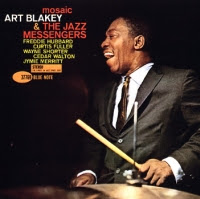Art Blakey & the Jazz Messengers - Mosaic (1960)
 Adding a sixth musician to the Jazz Messengers proved to be one of the most momentous decisions of Art Blakey's career. It was not entirely unprecedented (Leonard Feather to the contrary notwithstanding), as the Messengers did field a team of six briefly in 1957. That edition, featured on the Vik album A Night in Tunisia, featured a front line of trumpet, alto sax, and tenor sax, a three-horn blend that Blakey favored in the late 1970s and early 1980s, after economic constraints had forced him to revert to a quintet setup for roughly a decade. During the final few years of his life, the drummer even found occasion to carry trumpet, trombone, and two saxophones in the Messengers. Yet the configuration that earned the right to be considered classic, thanks to the musicians heard on the present recording, featured trumpet, trombone, and tenor sax in the front line.
Adding a sixth musician to the Jazz Messengers proved to be one of the most momentous decisions of Art Blakey's career. It was not entirely unprecedented (Leonard Feather to the contrary notwithstanding), as the Messengers did field a team of six briefly in 1957. That edition, featured on the Vik album A Night in Tunisia, featured a front line of trumpet, alto sax, and tenor sax, a three-horn blend that Blakey favored in the late 1970s and early 1980s, after economic constraints had forced him to revert to a quintet setup for roughly a decade. During the final few years of his life, the drummer even found occasion to carry trumpet, trombone, and two saxophones in the Messengers. Yet the configuration that earned the right to be considered classic, thanks to the musicians heard on the present recording, featured trumpet, trombone, and tenor sax in the front line.At the time these tracks were recorded in 1961, one could be forgiven for believing that this particular sextet blend would become the standart across the spectrum of modern jazz ensembles. The edition of JJ Johnson's band from which Freddie Hubbard and Cedar Walton emerged employed the same lineup, as did the Art Farmer-Benny Golson Jazztet that, at seperate points, included Walton and Curtis Fuller. When Johnson disbanded his own unit, he briefly joined Miles Davis and turned that group into a trumpet/trombone/tenor outfit. It could be that this particular instrumentation, with each of a big band's three horn sections represented, particular a natural environment for scaled-down jazz writing, but a more likely factor in the sudden emergence of sextets was the availability of Johnson and Fuller, two virtuosos who could blow toe-to-toe with their trumpet and sax-playing peers.
Blakey had first used trombone as a third horn in June 1961, when Lee Morgan and Bobby Timmons were still aboard, for his Impulse album Art Blakey and the Jazz Messengers. In the notes to that set, Dick Katz states that Fuller "was engaged especially for this album", but the trombonist's strong soloing and his Messengers-friendly composition "Alamode" made an immediate impression upon Blakey, who brought the trombonist on as a permanent member two months later when Hubbard and Walton joined the group. The new sextet attempted to cut its first recording at the Village Gate on August the 17th, but the session was rejected (two tracks included "Arabia", did finally surface on the 1990 CD Three Blind Mice Vol 2). Less than two months later, when the band recorded Mosaic on its first visit to Rudy van Gelder's studio, the results were far superior, and the Messengers were immediately refashioned in the eyes of its fans as a six-piece band.
All five of the compositions included here became Jazz Messengers classics, yet it appears that at least three of them were not written with Blakey's band in mind. The title track, which seems custom-made for the leader's percussive fire, was actually part of the Jazztet's book when composer Walton was with that band, and had received its debut recording four months earlier on Clifford Jordan's Jazzland album, Starting Time. "Arabia", another of Fuller's modal efforts, was first heard on his August 1959 Savoy album The Curtis Fuller Jazztet with Benny Golson, which also featured a three-horn front line completed by then-Messenger Lee Morgan. Hubbard also employed a sextet, albeit with euphonium and tenor sax, when he cut a slower version of "Crisis" on 21 August 1961, date that produced his Blue Note album Ready for Freddie.
As to the other titles, Shorter has said that, "I was thinking about Bela Lugosi in Dracula when I wrote Children of the Night, but the children also became astronauts, going out into the unknown." And Hubbard's "Down Under" with its comfortable blues groove and break figures that recall Lee Morgan's "What Know", is most reminiscent of the already established Messengers tradition. It is also what may have been considered the album's soul track, at a point when something soulful was de rigueur on a jazz album. It is one measure of the expanded Messengers' success that they were able to thrive without relying on music calculated to meet some standart of ersatz sanctification. All of Blakey's music possessed soul, but this band and this album offered so much more.
